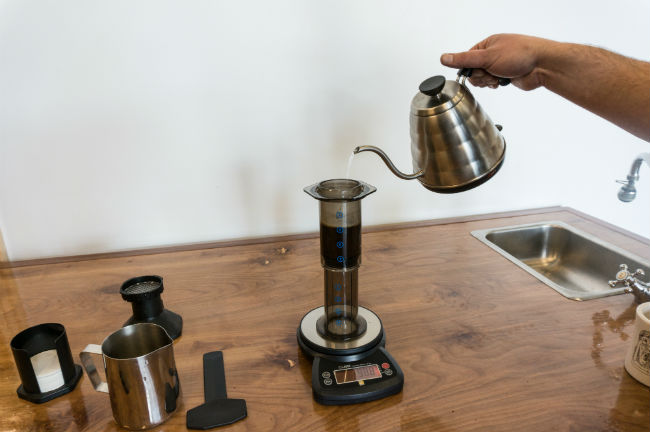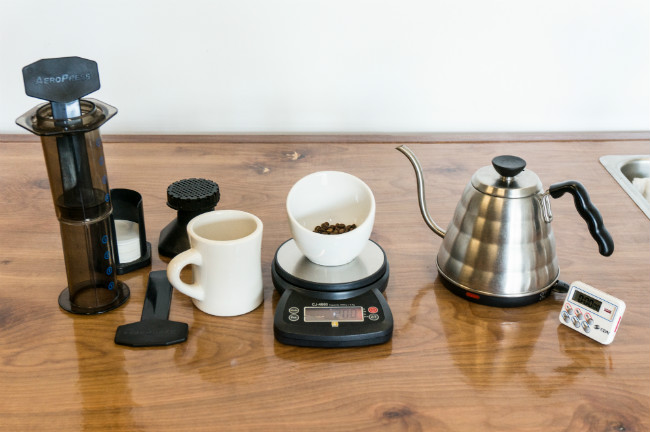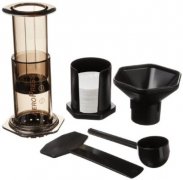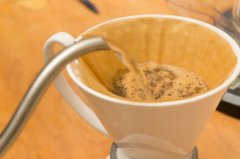Upside-down AeroPress: Philharmonic pressure reverse pressure coffee brewing course

For professional baristas, please follow the coffee workshop (Wechat official account cafe_style)
When it comes to brewing coffee with an AeroPress coffee machine, there are two main ways. The first method is described in the directions provided with Aerobie AeroPress and our AeroPress Coffee maker tutorial. This is a conventional top-down direct brewing method.
The second method is called upside-down or upside-down brewing, which I will emphasize in this brewing tutorial.
Which method is best for experts to split? According to Zachary Crockett's "AeroPress Invention" article, "about half" of AeroPress World Championship champions use the inversion method. Proponents of the reverse approach claim it is a "complete immersion", while critics say flipping looks cool and offers no extra benefits.
AeroPress Coffee and Espresso manufacturer with bonus 350Mini filter
Aeropress Coffee and Espresso Maker (Amazon USA, Amazon Canada)
Reversal could mean an end to the leak.
I like the two methods of AeroPress brewing, but I often use the inversion method. Not because it looks cool, but because standard brewing methods sometimes leak before the brewing cycle is complete.
You can use the following tips to minimize the chances of brewing your standard AeroPress.
Wet filter paper.
Make sure the paper filter is not folded and placed evenly in the filter cover.
Make sure the seal is tight.
The grinding may be too rough.
Using the funnel that comes with the AeroPress, the loose ground will not enter the filter seal.
Some people find that using larger cups can reduce the chance of leakage.
Or you can use it upside down.
At 6: 00 in the morning, I want my brewing method to be as stupid as possible. The only way to really subvert inversion is to get out of control during the flipping process. It is still possible to leak by inversion, but what is important is far less than what happens at the end of the brewing phase after the coffee is ready to leave the brewing room.
Many changes (recipes) work
AeroPress, invented in 2005, is very young when it comes to coffee brewing. Since then, coffee professionals have improved the Aerobie instructions provided by each unit with great interest.
There are many AeroPress competitions around the world today. When you search for award-winning recipes, you will find that the methods are very different. There are great differences in brewing temperature, grinding size, brewing time and even falling time.
At first glance, the complexity of recipes may seem scary, but they shouldn't. In fact, people use very different parameters to make amazing coffee, telling us that AeroPress is harder to screw up than other coffee brewing methods.
For this tutorial, we will keep it simple. Once you have the basics, venture out and try some award-winning recipes.
List
Before we begin, make sure you have everything.
AeroPress Coffee Brewing Settings
Brewing room of AeroPress coffee machine.
Plunger.
Blender if you lose the one that comes with AeroPress, please use a spoon.
Black filter cover
Paper filter (or you can replace it with a reusable metal filter, such as Able Brewing DISK).
A spoon in a kitchen scale or box.
kettle
Timer or stopwatch.
Cup
Coffee.
Filter or drinking water.
(optional, not in the photo) AeroPress funnel.
# 1 ground coffee and hot water
A single AeroPress spoon is equivalent to 2 tablespoons or about 17 grams. Measuring coffee by volume will be more accurate than weight. The article why you should use proportion to brew coffee is likely to throw away your spoon and grab the proportion.
Although I agree with this article, for AeroPress, I find it very tolerant, with a few grams of change in brewing. Don't think that lack of scale will stop you from brewing quality coffee.
Aerobie recommends grinding between drip irrigation and espresso. I use dripping water to grind others with thicker grinding. When it comes to grinding dimensions, AeroPress is super tolerant. As a general rule, the finer you grind, the shorter the brewing time will be.
The corner next to the grinding grade of air cushion coffee
# 2 set AeroPress upside down and add coffee
Place the plunger up on the counter. Now turn the brewing chamber upside down and place it on the plunger. You will want the plug to rest in the middle of position # 4.
If you are worried about flipping, you can push it further, so the whole # 4 is under the plug. Other recipes say the whole # 4 should be above the plug, but in my opinion, this is too unstable. A bumpy, you have a hot mess to clean up.
Add ground coffee. If you still have it, use the AeroPress funnel. I lost me. I hope I didn't, because the funnel makes it easier for all the coffee grounds to get into the brewing room without staying on the edge of the brewer.
Inverted balloons and ground Coffee
# 3 insert and flush the filter
Place the filter in the filter cover and rinse with water. Now put it aside.
Rinse Aeropress coffee filter
# 4 start the timer, add hot water and stir
How hot should the AeroPress brewing water be? There are different opinions here. Most recipes say use 200-205F. Aerobie recommends 175F. From Aeropress FAQ:
Books often recommend boiling temperatures from 195 °F to 200 °F (91 °C to 93 °C). This is beneficial to the traditional brewing method of passing hot water through the coffee bed. In this method, the water cools quickly, so the lower part of the bed runs at a lower temperature. In AeroPress, however, all coffee particles are exposed to the same water temperature during stirring.
The top three winners of the 2014 World Aviation Championships have brewing temperatures of 174 F (78 C), 197 F (92 C) and 180 F (82 C). In the past few years, you have won a recipe that has just boiled over. The lesson here is that AeroPress can be brewed over a wide temperature range.
To keep it simple, I boiled the water and let it cool for 20-30 seconds. If you have a programmable kettle, experiment.
Start the timer
There are two ideas of heating hot water and stirring.
Add half of the water, stir, and then add the remaining water.
Add all the water and stir.
Although I have heard controversial claims that the first is better, I have achieved these two ways and cannot distinguish between them. The important thing in this step is to make sure that all coffee powder is in contact with water. Try two ways for yourself.
Pour hot water into AeroPress coffee.
Stir Aeropress coffee with paddle
Because I used it more thoughtfully, I filled half of the water between # 1 and # 2 laps.
The water is full of AeroPress coffee-brewing
# 5 fixed filter cover on AeroPress
Press and hold the AeroPress that the two rooms meet, with the other hand, and screw the filter onto the beer machine.
AeroPress Coffee Safety filter
# 6 in 60-90 seconds, flip and press
There are many different brewing times available. A good starting range is 60-90 seconds. When this time passes, AeroPress grabs the two rooms together and flips it, so it's in your cup.
Once the AeroPress is from the right up and close to the cup, continue to press the plunger. Use a slow press. Press completely for about 20 seconds.
Aeropress Coffee-Flip and plunge
# 7 seasoning with water
You are now the essence of coffee and add some hot water to achieve the consistency of brewing coffee. Usually this would mean adding 50% of the water. If you want a cup of iced coffee, just pour a cup of ice.
I should also add that if you want a "espresso like" drink, you don't need to add anything. Because AeroPress can't produce the pressure of a real espresso machine, I don't think it's espresso. Home coffee is not owned by baking retailer Sweet Maria either. From their AeroPress page:
Illy's research shows that espresso is brewed at a pressure of 7-11 bar and the water temperature is between 194F and 203F (no temperature loss on the cold coffee handle, etc.). Even though AeroPress has the sensory characteristics of espresso and the appearance of coffee, I don't think it is within these parameters.
If you go to the "espresso like" route, you can try using less water, finer grinding and shorter brewing time.
The most primitive brewing method
I have tried many different ways to brew coffee, and none of them is as forgiving as AeroPress. You can use a variety of grinding, temperature and dose brewing, you can still make high-quality coffee. You can even flip it upside down and be good at it.

Important Notice :
前街咖啡 FrontStreet Coffee has moved to new addredd:
FrontStreet Coffee Address: 315,Donghua East Road,GuangZhou
Tel:020 38364473
- Prev

American coffee master AeroPress Philharmonic pressure positive pressure coffee operation course
Aerobie AeroPress is a single cup coffee brewing system that will provide excellent use on the road and even as a solution for high-quality office coffee. The price of the system is between $25 and $30, which I think is reasonable. In addition to the core brewing system, you can also get 350 AeroPress filters and one holder. This equipment is equipped with several other coffee brewing methods.
- Next

Bonavita ceramic smart filter cup use tutorial, step-by-step cooking demonstration ~
Professional baristas please follow the coffee workshop (Wechat official account cafe_style) French news agency offers a wealth of delicious coffee, but it has two disadvantages. The first one is sediment. In order to minimize sediment, I made a practice, do not pour all the coffee into the cup, do not drink the last few sips. But occasionally I forget that my last cup of coffee will be bitter.
Related
- What is the Philharmonic pressure? How to use Philharmonic pressure to make delicious coffee
- Why does a hand grinder have more fine powder than an electric grinder?
- In addition to the hot mom, what is the difference between the versions of EK43 | ditting and Mahdi ek43?
- What kind of equipment do you need to make coffee by hand? Introduction to novice starter cooking equipment tools
- Espresso needs to be ground how thick and thin scale entry Italian Coffee Machine Bean Grinder investigation and Grinding course
- How much does it cost to open a small private cafe? How much does it cost to learn coffee? How to operate it?
- The difference between the flavor characteristics of hand-brewed coffee and coffee maker is hand-brewed coffee really better than coffee maker? Can I use a coffee machine to make coffee beans by hand?
- The difference between 01 and 02 of hario v60 filter cup what is the difference between 01 and 02 filter cup opening and cooking flavor
- What's the difference between the smart cup and the French kettle? Which is better, the French kettle or the Smart Cup?
- What's the difference between a smart cup and a V60 filter cup? The difference between the taste of smart cup and hand-brewed coffee

